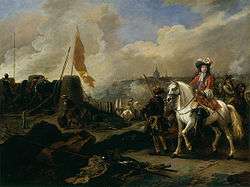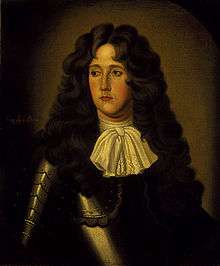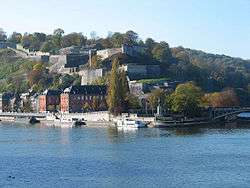James Douglas (English Army officer)
| Lieutenant-General James Douglas | |
|---|---|
 Drumlanrig Castle, the Queensberry estate; constructed between 1679-1689 | |
| Born |
1645 Drumlanrig Castle, Dumfriesshire |
| Died |
December 1691 (aged 45–46) Namur, Spanish Netherlands |
| Allegiance |
|
| Service/ | Infantry |
| Years of service | 1672 - 1691 |
| Rank | Lieutenant-General |
| Unit |
Lockhart's Regiment 1672-1674 Dutch Scots Brigade 1674-1684 Scots Footguards, 1684-1691 |
| Commands held |
Master-General of the Ordnance, Scotland October 1685 - March 1688 Commander in Chief, Scotland March - November 1688 |
| Battles/wars |
Third Anglo-Dutch War 1672-1674 Siege of Maastricht (1673) Franco-Dutch War 1672-1678 Siege of Maastricht 1676 Cassel 1677 Saint-Denis 1678 Battle of Bothwell Bridge 1679 Argyll's Rising 1685 Williamite War in Ireland 1689-1691 The Boyne 1690 First Siege of Athlone 1690 |
Lieutenant-General James Douglas (1632-1691) was a Scottish military officer who served successively with the French army and the Dutch Scots Brigade, was appointed Commander in Chief for Scotland by James II and held senior commands under William III in the 1689-1691 Williamite War in Ireland. He died of fever at Namur in the Spanish Netherlands in 1691 during the Nine Years War.
Life
James Douglas was the second son of the Earl of Queensberry (ca 1608-1671), and his wife Lady Margaret Stewart (1620-1672). The Earl was a Presbyterian who signed the 1638 National Covenant and took little part in the 1639-1651 Wars of the Three Kingdoms. He was arrested in 1645 for attempting to join Montrose's Royalist campaign but was released after paying a fine.[1] The Douglas family largely retained its position and estates throughout the various changes of regime in the 17th century.[2]
In 1665, he qualified as an advocate and in 1672, joined Sir William Lockhart's Regiment, part of an Anglo-Scots force detached to the French Army between 1672-1674. His younger brothers John (1647-1675) and Robert (1650-1676) also became army officers; John was killed at Trier serving with the Régiment de Douglas in 1675, while Robert died in 1676, during the recapture of Maastricht by the Dutch.[3]
He married Anna Hamilton and they had two sons, James and William.[4] James received a commission in his father's regiment in 1688 but resigned in October 1691 and died in 1700; William died in 1712.[5]
Career

As a result of the Wars of the Three Kingdoms, many in both Scotland and England viewed standing armies as a threat to individual liberty and society itself.[6] Those who wanted a military career joined units in foreign service, such as the French Irish Brigade or the Dutch Scots Brigade. Loyalties were often based on religion or personal relationships, with officers moving between armies; Marshall Turenne (1611-1675), considered the greatest French general of his time, was a Protestant who served in the Dutch army from 1625-1630.[7]

In the 1670 Treaty of Dover signed by Charles II and Louis XIV, England agreed to an alliance against the Dutch Republic and the supply of 6,000 troops for the French army.[8] The Treaty contained secret provisions, which were not revealed until 1771, one being the payment to Charles of £230,000 per year for the services of this Brigade.[9]
James Douglas was appointed Captain in Sir William Lockhart's Regiment, recruited as part of the Anglo-Scots Brigade; when the Franco-Dutch War began in 1672, it fought with the French in Flanders, under the command of the Duke of Monmouth, Charles' illegitimate son.[10] However, the alliance with Catholic France was deeply unpopular, especially in Scotland with its close cultural and economic links to the Dutch Republic, and England withdrew from the war with the 1674 Treaty of Westminster.[11]
To keep his French subsidies, Charles encouraged members of the Anglo-Scots force to remain in French service; many did so, among them Monmouth and John Churchill, future Duke of Marlborough. Others enrolled in the Dutch Scots Brigade, including Douglas and a fellow officer in Lockhart's Regiment, John Graham, later Viscount Dundee.[12]
%2C_prins_van_Oranje._Stadhouder%2C_sedert_1689_tevens_koning_van_Engeland_Rijksmuseum_SK-A-1228.jpeg)
The Scots Brigade had served in the Dutch army since the 1580s and despite the name, normally contained a mixture of regiments from Scotland and England; withdrawn in 1672, the English units were restored in 1674. Over the years, the Scots regiments had lost much of their national identity; to change this and reduce the number of unemployed veterans who might otherwise stay with the French, a deliberate policy was adopted to re-establish them as Scottish units.[13] James joined Colyear's Regiment in the Scots Brigade, as did his brother Robert, killed at Maastricht in 1676; a Lieutenant-Colonel when the war ended in August 1678, he was promoted Colonel in March, 1680.[14]
Douglas was in Scotland during the Covenanter rebellion of June, 1679 and took part in the Battle of Bothwell Bridge that ended it. He was awarded the lands of Patrick Murdock of Cumloden, one of those convicted for their participation; the grant was confirmed in April 1685.[15]
The complex mix of loyalties during this period is shown by his connections to the Catholic George Douglas, later Earl of Dumbarton, Colonel of the 'Régiment de Douglas,' later the Royal Scots.[16] From its formation in 1633 to 1679, this was chiefly employed by France and James' younger brother John was serving with it when he died at Trier in 1675. Without a standing army, units like this and the Scots Brigade were an important source of military professionals for the English Crown, which took an interest in the appointment of officers and also controlled recruitment.[17]

Scottish politics in the 1680s was dominated by his elder brother, the Marquess of Queensberry, who was appointed Treasurer of Scotland in 1682.[18] James returned to Scotland permanently in June 1684, after the Earl of Linlithgow was persuaded to relinquish his position as Colonel of the Scots Footguards in his favour.[19] The need for a reliable Protestant soldier in Scotland was driven by several factors, one being the conflict between Queensberry and his former colleague Dundee, a favourite of the future James II and now the chief military power in Scotland.[20]
The second factor was an administrative loophole whereby troops designated as 'garrisons' were largely exempt from Parliamentary control. In early 1684, the colony of Tangier was abandoned; apart from the expense, Parliament was concerned the Tangier Garrison was a 'nursery for Popish soldiers.'[21] This concern increased when all three Tangier regiments were designated 'garrison' troops on their return to England in early 1684 and thus remained in being.[22]
James II succeeded Charles in April 1685 with widespread support in both countries; the 1681 Scottish Test Act required all public officials and MPs to swear unconditional loyalty to the monarch, 'regardless of religion,' but with the crucial qualifier that they 'promise to uphold the true Protestant religion.'[23] The religious conflicts of the 17th century meant most Scots saw both dissident Presbyterians and Catholics as threats and opposed 'tolerance' for either, one reason why Argyll's Rising collapsed so quickly in June 1685.[24]

He played an active role in the suppression of Argyll's Rising; the Tweedsmuir cemetery contains a memorial to John Hunter, cruelly murdered at Core Head by Col. James Douglas and his party for his adherence to the Word of God and Scotland’s Covenanted Work of Reformation 1685.[25] In October, William Drummond, Viscount Strathallan was appointed Commander-in-Chief, Scotland, with James as Master-General of the Ordnance.[26]
After Strathallan died in March 1688, Douglas assumed the position of Commander-in-Chief but it is not clear whether he was ever officially appointed as such and operational control was largely exercised by Dundee.[27] In 1685, many supported James from fear of civil war if he were bypassed; by July 1688, anti-Catholic riots made it seem only his removal could prevent one.[28]
The Scottish army was brought south to join the rest of James' forces after William of Orange landed in Brixham on 5 November, but his troops deserted and he went into exile on 23 December.[29] Hugh Mackay, another former Scots Brigade colleague, replaced Douglas as Commander in Scotland.[30]
In March, 1689, James II launched the 1689-1691 Williamite War in Ireland and Douglas joined the Williamite army led by Frederick Schomberg. He was entrusted with a number of independent commands, although William was generally reluctant to entrust English or Scots officers with senior positions, regarding them as less trustworthy or competent than the Dutch or Germans.[31] He was considered a good soldier, but Schomberg found him hard to work with and he had a reputation as a martinet.[32] He led a Brigade at the Battle of the Boyne and the First Siege of Athlone, then was posted to Spanish Netherlands in May 1691, along with Percy Kirke and Sir John Lanier. This was allegedly a combination of personal animosities, while all three were also accused of indiscriminately looting the goods of those who had already submitted, Catholic and Protestant alike.[33]
All three were dead within a year; Kirke died in Brussels in October, while Lanier was killed at Steenkerque in August 1692.[34] Douglas also died of disease at Namur in July 1691 and was succeeded as Colonel of the Foot Guards by George Ramsay, another former Scots Brigade colleague.[35]
References
- ↑ Le Neve, John (1712). Memoirs British and Foreign, of the Lives and Families of the Most Illustrious Persons (2015 ed.). Arkose Press. p. 456. ISBN 978-1345713763. Retrieved 12 October 2018.
- ↑ Debrett, John (1814). "Scotland and Ireland". F. C. and J. Rivington and others. p. 637.
- ↑ Le Neve, John (1712). Memoirs British and Foreign, of the Lives and Families of the Most Illustrious Persons (2015 ed.). Arkose Press. p. 456. ISBN 978-1345713763. Retrieved 12 October 2018.
- ↑ Balfour Paul, James (1910). The Scots Peerage. p. 136.
- ↑ Dalton, Charles (1909). The Scots Army 1661-1688. London & Edinburgh: Eyre & Spottiswoode. p. 87.
- ↑ Childs, John (1987). The British Army of William III, 1689-1702 (1990 ed.). Manchester University Press. p. 184. ISBN 0719025524.
- ↑ "Turenne 1611-1675". Musée virtuel du Protestantisme. Retrieved 5 October 2018.
- ↑ Lynn, John (1996). The Wars of Louis XIV, 1667-1714 (Modern Wars In Perspective). Longman. pp. 109–110. ISBN 978-0582056299.
- ↑ J. P. Kenyon, The History Men. The Historical Profession in England since the Renaissance. Second Edition (Weidenfeld and Nicolson, 1993), pp. 67-68.
- ↑ Harris, Tim. "Scott [formerly Crofts], James, duke of Monmouth and first Duke of Buccleuch (1649–1685)". Oxford DNB. Retrieved 5 October 2018.
- ↑ Davenport, Frances (1917). "European Treaties bearing on the History of the United States and its Dependencies". p. 238. Retrieved 7 October 2018.
- ↑ Linklater, Magnus. "Graham, John, first viscount of Dundee [known as Bonnie Dundee". Oxford DNB. Retrieved 5 October 2018.
- ↑ Miggelbrink Joachim (2002). McKilliop, Andrew; Murdoch, Steve, eds. Fighting for Identity: Scottish Military Experiences c.1550-1900. Brill. pp. 91–92. ISBN 9004128239.
- ↑ Dalton, Charles (1909). The Scots Army 1661-1688. London & Edinburgh: Eyre & Spottiswoode. p. 78.
- ↑ "Ratification in favour of Colonel James Douglas and Robert Barton". Parliamentary Register. Retrieved 14 October 2018.
- ↑ Offen, Lee. "Dumbarton's Regiment". Historyreconsidered.net. Retrieved 5 February 2018.
- ↑ Glozier, Mathew (2004). Scottish Soldiers in France in the Reign of the Sun King: Nursery for Men of Honour. Brill. p. 192. ISBN 900413865X.
- ↑ Ford, JD (2004). "Douglas, William, first duke of Queensberry (1637–1695)". Oxford DNB. doi:10.1093/ref:odnb/7936. Retrieved 5 October 2018.
- ↑ Dalton, Charles (1909). The Scots Army 1661-1688. London & Edinburgh: Eyre & Spottiswoode. p. 51.
- ↑ Linklater, Magnus. "Graham, John, first viscount of Dundee [known as Bonnie Dundee". Oxford DNB. Retrieved 5 October 2018.
- ↑ Cannon, Richard (1846). Historical Record of the First, or Royal Regiment of Foot: Containing an Account of the Origin of the Regiment in the Reign of King James VI of Subsequent Services to 1846 (2012 ed.). Forgotten Books. p. 67.
- ↑ Childs, John (2014). General Percy Kirke and the Later Stuart Army. Bloomsbury Academic. pp. 62–63. ISBN 978-1441158826.
- ↑ Harris, Tim; Taylor, Stephen, eds. (2015). The Final Crisis of the Stuart Monarchy. Boydell & Brewer. p. 122. ISBN 1783270446.
- ↑ Harris, Tim (2007). Revolution; the Great Crisis of the British Monarchy 1685-1720. Penguin. pp. 153–157. ISBN 0141016523.
- ↑ Dumfries and Galloway Council. "The Killing Times" (PDF). Southern Upland Way. Retrieved 14 October 2018.
- ↑ Dalton, Charles (1909). The Scots Army 1661-1688. London & Edinburgh: Eyre & Spottiswoode. p. 74.
- ↑ Childs, John (2008). The Williamite Wars in Ireland. Bloomsbury 3PL. pp. 232–234. ISBN 978-1847251640.
- ↑ Wormsley, David (2015). James II: The Last Catholic King. Allen Lane. p. 189. ISBN 014197706X.
- ↑ Harris, Tim (2007). Revolution; the Great Crisis of the British Monarchy 1685-1720. Penguin. pp. 3–5. ISBN 0141016523.
- ↑ Macpherson, James (1775). Original Papers: Containing the Secret History of Great Britain (2017 ed.). Hansebooks. pp. 357–358. ISBN 3-7434-3572-1.
- ↑ Chandler, David (ed), Beckett, Ian (ed), Childs, John (author) (1994). The Restoration Army 1660-1702 in The Oxford History of the British Army (1996 ed.). OUP. p. 64. ISBN 0192803115.
- ↑ Childs, John (2008). The Williamite Wars in Ireland. London: Bloomsbury 3PL. p. 232. ISBN 978-1847251640. Retrieved 7 October 2018.
- ↑ Dalton, Charles (1909). The Scots Army 1661-1688. London & Edinburgh: Eyre & Spottiswoode. p. 85.
- ↑ Dalton, Charles (1909). The Scots Army 1661-1688. London & Edinburgh: Eyre & Spottiswoode. p. 86.
- ↑ "Colonels in the 3rd Regiment of Footguards". British Empire. Retrieved 7 October 2018.
Sources
- Balfour, Paul; The Scots Peerage, Volume III;
- Cannon, Richard; Historical Record of the First, or Royal Regiment of Foot: Containing an Account of the Origin of the Regiment in the Reign of King James VI of Subsequent Services to 1846; (2016 ed.);
- Chandler, David (ed), Beckett, Ian (ed), Childs, John (author); The Restoration Army, 1660-1702; in The Oxford History of the British Army; (OUP, 1996 ed);
- Childs, John; General Percy Kirke and the Later Stuart Army; (Bloomsbury Academic, 2014);
- Dalton, Charles; The Scots Army 1661-1688; (Eyre & Spottiswoode, 1909);
- Davenport, Frances; European Treaties bearing on the History of the United States and its Dependencies; (1917)
- Glozier, Matthew; Scottish Soldiers in France in the Reign of the Sun King: Nursery for Men of Honour; (Brill, 2004);
- Harris, Tim; Scott [formerly Crofts], James, duke of Monmouth and first Duke of Buccleuch (1649–1685); (Oxford DNB);
- Harris, Tim, Taylor, Stephen, eds; The Final Crisis of the Stuart Monarchy; (Boydell & Brewer, 2015);
- Jackson, Clare; Restoration Scotland, 1660-1690: Royalist Politics, Religion and Ideas; (Boydell Press, 2003);
- Le Neve, John; Memoirs British and Foreign, of the Lives and Families of the Most Illustrious Persons; (1712; Arkose Press, 2015 ed);
- Lynn, John; The Wars of Louis XIV, 1667-1714 (Modern Wars In Perspective); (Longman, 1996);
- Macpherson, James; Original Papers: Containing the Secret History of Great Britain; (Hansebooks, 2017 ed);
- Miggelbrink, Joachim (author) McKilliop, Andrew and Murdoch, Steve, eds; Fighting for Identity: Scottish Military Experiences c.1550-1900; (Brill, 2002);
External Links
- "Turenne 1611-1675". Musée virtuel du Protestantisme. Retrieved 5 October 2018. ;
- Offen, Lee. "Dumbarton's Regiment". Historyreconsidered.net. Retrieved 5 February 2018.
- "Colonels in the 3rd Regiment of Footguards". British Empire. Retrieved 7 October 2018.
| Military offices | ||
|---|---|---|
| Preceded by The Earl of Linlithgow |
Colonel of the Scots Regiment of Foot Guards 1684–1691 |
Succeeded by Hon. George Ramsay |